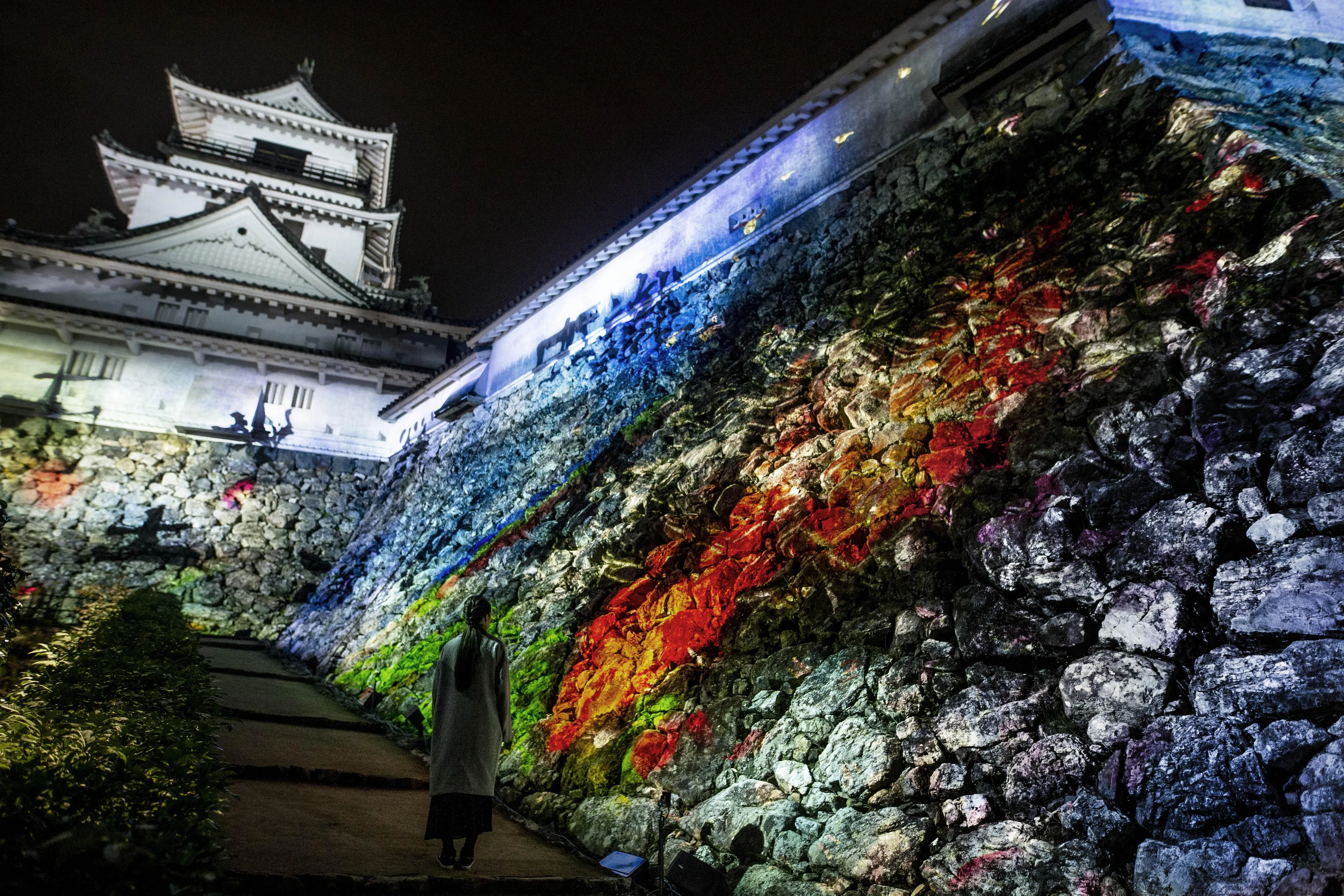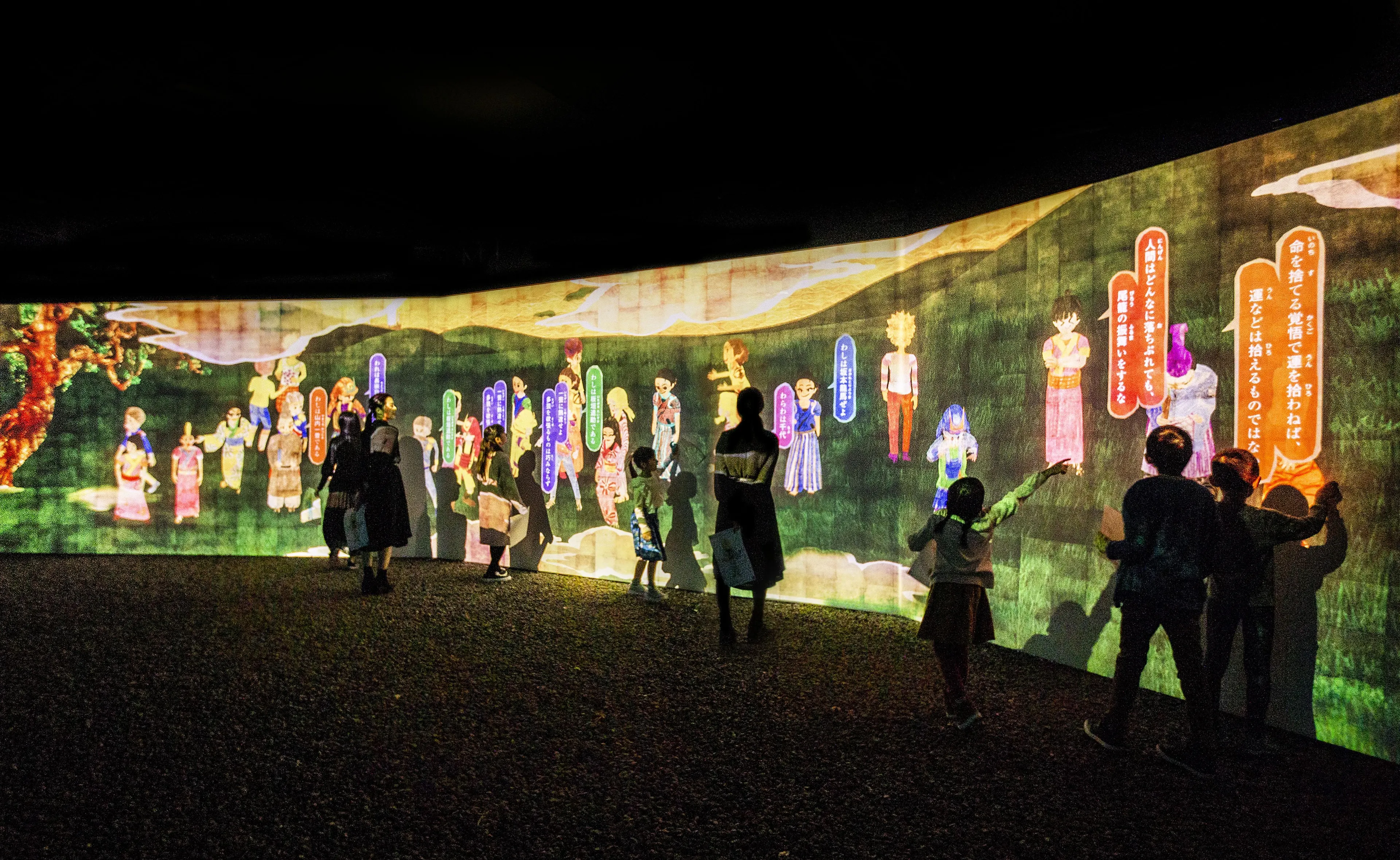teamLab: Digitized Kochi Castle

المعارض السابقة
2020.1.13(Mon) - 2019.11.08(Fri)Kochi Castle, Kochi
Within Kochi Castle, there are many dark or unlit areas. Visitors are advised to wear clothes and footwear that are easy to move in for safety.

المعارض السابقة
2020.1.13(Mon) - 2019.11.08(Fri)Kochi Castle, Kochi
Within Kochi Castle, there are many dark or unlit areas. Visitors are advised to wear clothes and footwear that are easy to move in for safety.
teamLab: Digitized Kochi Castle
Kochi Castle was built over a period of about 10 years starting in 1601. Despite it being destroyed in a fire, it was rebuilt in the middle of the Edo period and restored to its original form. Kochi Castle is considered an important historical site in Japan, as it is the only castle where the castle tower and nearly all of the central structure remain intact.
This exhibition is a part of teamLab’s Digitized City art project. The concept behind the project is that non-material digital technology can turn a city into art without physically altering it.
Kochi Castle has stood from the Edo period to the present day and remains an important symbol for the city of Kochi. teamLab: Digitized Kochi Castle will transform the castle into an interactive digital art space that changes due to the presence of people. This in turn, enhances the presence of humans, and transforms the relationship between people in the same space with digital art.
This exhibition is a part of teamLab’s Digitized City art project. The concept behind the project is that non-material digital technology can turn a city into art without physically altering it.
Kochi Castle has stood from the Edo period to the present day and remains an important symbol for the city of Kochi. teamLab: Digitized Kochi Castle will transform the castle into an interactive digital art space that changes due to the presence of people. This in turn, enhances the presence of humans, and transforms the relationship between people in the same space with digital art.
الأعمال الفنية
حول تيم لاب
"تيم لاب" هو عبارة عن مجموعة فنيّة عالمية (تأسست عام 2001)، يتم التعاون فيها بهدف التعمّق في نقاط الالتقاء بين الفن والعلوم والتكنولوجيا والعالم الطبيعي. فعبر الأعمال الفنيّة، تهدف مجموعة من الخبراء ذوي الاختصاصات المختلفة، بمن فيهم فنانين ومبرمجين ومهندسين، وأخصائي رسوم متحركة، وعلماء رياضيات ومهندسين معماريين، إلى استكشاف العلاقة بين الذات والعالم وأشكال جديدة من الإدراك.
وفي محاولة إلى فهم العالم حولهم، يسعى الناس إلى فصله إلى وحدات مستقلة يتصوّرون حدودًا في ما بينها. ولكن "تيم لاب" يسعى إلى تجاوز هذه الحدود التي تحدّ رؤيتنا ونظرتنا إلى العالم وإلى العلاقة بين الذات والعالم واستمرارية الزمن. فكل شيء قائم في استمرارية بلا حدود، في استمرارية مستدامة وهشّة وخارقة في آن واحد.
تتواجد أعمال "تيم لاب" من ضمن المجموعة الدائمة لمعرض فكتوريا الوطني في ملبورن، ومعرض الفنون نيو ساوث ويلز في سيدني، ومعرض فنون جنوب أستراليا في أديلايد، ومعرض أستراليا الوطني في كانبيرا، ومتحف الفنون آموس ريكس في هلسنكي، ومتحف الفن المعاصر في لوس أنجلوس، ومتحف الفن الآسيوي في سان فرانسيسكو، ومتحف مجموعة بوروسان للفن المعاصر في إسطنبول، وجمعية متحف آسيا في نيويورك، وغيرها.
تيم لاب
وثائق السيرة الذاتية
يتم تمثيل أعمال "تيم لاب" من قبل معرض بايس، ومعرض مارتن براون للفنون المعاصرة، ومعرض إيكان للفنون.
MAP
تفاصيل المكان
teamLab: Digitized Kochi Castle 2019-2020
الفترة
2020.1.13(Mon) - 2019.11.08(Fri)
الوقت
17:30 – 21:30 (Last entry 21:00)
رسوم الدخول
Exhibition Admission:
Early Bird
Available at Convenience Stores in Japan
(Seven-Eleven, LAWSON, Mini stop, Family Mart)
[Number] 0252237 * Common number among all convenient stores above.
[Item] teamLab: Digitized Kochi Castle Early Bird Ticket
[Sales Period] October 15 (Tue) - November 7 (Thurs), 2019
Same Day Ticket
Available at on site and Convenience Stores in Japan
(Seven-Eleven, LAWSON, Mini stop, Family Mart)
[Number] 0252238 * Common number among all convenient stores stated above.
[Item] teamLab: Digitized Kochi Castle Same Day Ticket
[Sales Period] November 8 (Fri), 2019 - January 13 (Mon), 2020
Castle Tower Admission:
Only sold on site.
Early Bird
Available at Convenience Stores in Japan
(Seven-Eleven, LAWSON, Mini stop, Family Mart)
[Number] 0252237 * Common number among all convenient stores above.
[Item] teamLab: Digitized Kochi Castle Early Bird Ticket
[Sales Period] October 15 (Tue) - November 7 (Thurs), 2019
Same Day Ticket
Available at on site and Convenience Stores in Japan
(Seven-Eleven, LAWSON, Mini stop, Family Mart)
[Number] 0252238 * Common number among all convenient stores stated above.
[Item] teamLab: Digitized Kochi Castle Same Day Ticket
[Sales Period] November 8 (Fri), 2019 - January 13 (Mon), 2020
Castle Tower Admission:
Only sold on site.
Contact
وسائل المواصلات
العنوان
Kochi Castle
Kochi Park, 1-2-1 Marunouchi, Kochi City, Kochi
Kochi Park, 1-2-1 Marunouchi, Kochi City, Kochi
・15 min from Kochi Interchange by car.
・10 min from JR Kochi Station by car.
*For parking, please use the Kochi Park parking lot or the surrounding toll parking lots.
・3 minute walk from "Kochijo mae" Tosaden Kotsu tram stop
* From JR Kochi Station, switch tram at Harimayabashi.
Notes
・Kochi Castle and Kochi Park have stairs and unpaved roads. Due to the Law for the Protection of Cultural Properties, there are no access ramps.
・Visitors who come to the event drunk or otherwise pose a danger to themselves or others will be asked to leave.
・The exhibition may be closed due to severe weather.
・Entrance restrictions will apply if the venue reaches full capacity.
・The Organizers will not be held responsible for any injury, loss, or damage to personal items.
・Under no circumstances will refunds, exchanges or reissues be made after purchase.
・Visitors who come to the event drunk or otherwise pose a danger to themselves or others will be asked to leave.
・The exhibition may be closed due to severe weather.
・Entrance restrictions will apply if the venue reaches full capacity.
・The Organizers will not be held responsible for any injury, loss, or damage to personal items.
・Under no circumstances will refunds, exchanges or reissues be made after purchase.
المنظمون
teamLab: Digitized Kochi Castle Executive Committee






















